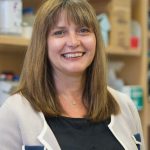Crunching GWAS Data
Fransiska Malfait, MD, PhD, a researcher at the Center for Medical Genetics at the University of Ghent in Belgium, talked about the strides being made in genetics to get at the root causes of disease.
“Over the past five to seven years, GWAS [genome-wide association studies] have been very successful in identifying susceptibility loci,” she said. “Over 1,200 GWAS have been successfully completed, identifying over 1,000 loci for over 200 common diseases.”
There has been a shift from the “common disease–common variant” hypothesis, the idea that common diseases are caused by the cumulative effect of very large set of common alleles.
“Most variants identified so far in these GWAS account for only small increments in risk and can currently explain only a small proportion of heritability of many of the common diseases,” Dr. Malfait said.
This problem of “missing heritability”—the recognition that a significant amount of heritability remains unexplained, even by the best-designed GWAS studies—has given rise to the “common disease–rare variant” hypothesis, the idea that common diseases can also be caused by rare variants with big effects.
Finding these variants, though, requires analysis of “massive amounts of genomes,” said Dr. Malfait, which hadn’t been possible until the advent of next-generation sequence platforms, which have exponentially increased the number of sequence data that can be generated.
These techniques are gradually becoming more affordable, she said. Whole genome sequencing now runs about $5,000. Whole exome sequencing—identification of changes in DNA that are a cause of or are related to medical concerns—costs $1,000 to $2,000. “This is expected to still drop,” Dr. Malfait said.
Now, she said, the problem isn’t generating the genetic information. “The bottleneck here is the data analysis,” she said.
Researchers in her laboratory are trying to discover the genetic underpinning of a certain subtype of Ehlers-Danlos syndrome. They started with five unrelated families with at least two affected family members. They performed exome sequencing for at least two affected family members per family.
Researchers didn’t zoom straight in to the gene that is the cause; instead, they found four different kinds of gene variations in all five families. “We still have not found the causative variant,” she said. “So it’s very difficult data analysis.”
Dr. Malfait acknowledged the ethical concerns that come with the possibility of incidental findings that are unrelated to the disease in question. She said patient awareness is essential, but there are no real guidelines, and institutional policies vary on this subject.
